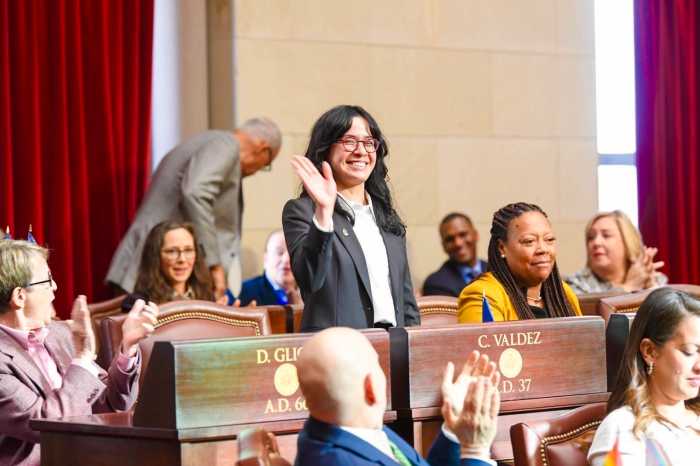As the city continues to be shrouded in a smoke-filled haze from Canadian wildfires, Mayor Eric Adams and senior administration officials Wednesday advised New Yorkers to stay indoors as much as possible, particularly those with underlying health conditions.
At 10 p.m. Tuesday night the city’s air quality index hit 218, a level considered to be “very unhealthy,” Adams and his team said during a Wednesday morning press briefing at New York City Emergency Management (NYCEM) headquarters in Downtown Brooklyn. But as of 7 a.m. Wednesday morning, air quality improved slightly to a score of 174 in the Bronx. New York City typically has a score of 50.
The polluted air conditions are expected to temporarily improve Wednesday night through Thursday morning, but then worsen that afternoon and evening, according to the mayor. NYCEM Commissioner Zach Iscol said that while smoke conditions are “notoriously difficult” to forecast, unlike weather, the administration expects this to be a “multiple day event.”
The smoke is traveling to the city from wildfires ravaging forests in the Quebec and Ontario regions of Canada, burning up millions of acres and triggering thousands to evacuate affected areas. The smoke first reached the Big Apple on Monday and air quality rapidly deteriorated on Tuesday, causing the state Department of Environmental Conservation to issue an air quality advisory for all five boroughs.
Adams emphasized he’s never experienced anything like the severely smoky haze that took hold on Tuesday, saying that when he went outside that afternoon he asked himself “what the hell is this?”
“Yesterday New Yorkers saw and smelled something that has never impacted us on this scale before,” Adams said. “As I was out walking the streets, clearly we knew something was happening that was beyond normal. The screen shots really show you the mist and the clouds that was over our city. We had dangerously high levels of wildfire smoke from thousands of miles away. From the gloom over Yankee Stadium to the haze obscuring our skyline, we could see it, we could smell it and we felt it.”

The five boroughs hadn’t experienced such poor air quality as it had on Tuesday since the 1960s, according to Health Commissioner Dr. Ashwin Vasan.
All New Yorkers should limit their time outdoors as much as possible, Vasan said, particularly children, seniors and those with breathing problems — like asthma — and heart conditions.
“The fine particulate matter in the air can get into people’s lungs, causing inflammation and worsen conditions like asthma, chronic lung disease or underlying heart conditions,” Vasan said. “Older adults may be particularly vulnerable due to declines in lung function and weaker immune systems. Children may also be more susceptible due to poor air quality because their lungs are still developing. Our health guidance to all New Yorkers is to limit outdoor activity as much as possible.”
If vulnerable individuals must go outside, Vasan advised they wear high-quality face coverings — such as N95 or KN95 masks.
The mayor and his team advised people to keep their windows and doors closed and use air purifiers, while limiting fresh-air intake from air conditions.
“This is not the day to train for a marathon or to do an outside event with your children,” Adams said.
They also cautioned that the current set of recommendations could change as the situation is rapidly evolving.

Vasan said his office has been in contact with leaders of the city’s public and private hospitals, who’ve communicated that they so far haven’t seen an increase in emergency room visits due to health impacts of the poor air quality. Dr. Mitchell Katz, who leads NYC Health + Hospitals (H+H), said that while the city’s public hospitals haven’t seen a surge in ER visits yet, people should continue to stay indoors so such an uptick doesn’t occur.
Iscol cautioned that the city could continue to see more of these smoky conditions over the next few months, given that the Canadian fire season began early this year and both the intensity and number of blazes is far greater than usual.
“What we do know is that fire season has come early,” Iscol said. “We know that generally fire season in Canada is in July. We know that we’re seeing [an] unprecedented number of fires and the difficulty they’re having putting it out. You put that together and it is likely that we will see further events like this.”
Read more: Denim Tears Giveaway Turns Chaotic on Lower East Side



































